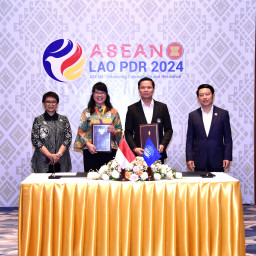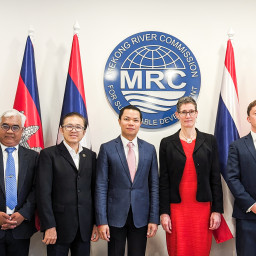Key priorities agreed for Cambodia-Lao PDR joint transboundary project
Vientiane, Lao PDR, 6 March 2019 – Officials from National Mekong Committees and line agencies of Cambodia and Lao PDR last week agreed on joint actions of key priorities for a joint project on cross-border water resource development and management between Cambodia (Stung Treng) and Lao PDR (Champasak).
At their Regional Steering Committee Meeting on 25 February in Cambodia’s Stung Treng and 26 February 2019 in Lao PDR’s Champasak, the two countries picked eco-tourism and fisheries management as the top priority for the project. They also deliberated on other issues that could be placed on the priority list, including land use planning and enforcement, irrigation and agricultural practices, gender issues, etc.
The Meeting also included field visits to the project areas and courtesy visits on the governors of the two provinces, all conducted as part of the finalization of the project planning process. The governors expressed their support to the project on mainstreaming prioritized actions into their provincial investment and development plans.

Participants visit a project site in Champasak province on 26 February
“I see the importance of this project and hope it will address some of the water resource related challenges we are experiencing now or may encounter in the future,” said Mr. Bounthong Divixay, Provincial Governor of Champasack Province.
“I hope this project will open up more opportunities for our people of the two countries while helping to address environmental impacts from development,” said Mr. Duong Peuv, Deputy Provincial Governor of Stung Treng.
Launched in early 2018 and running until 2021, the joint project is financed by the German development agency Deutsche Gesellschaft für Internationale Zusammenarbeit (GIZ) GmbH, as part of the MRC-Germany cooperation.
The project is transboundary in nature and seeks to better understand and manage the Mekong basin resources and address economic and social development challenges. It aims to develop shared visions on water related development and management aspects for collaboration between the two provinces that will finally be mainstreamed into their provincial investment and development plans.
The project’s outcome will also feed into the update of the MRC’s basin development strategy – a long term document that seeks to address current and future challenges facing the Mekong River basin – and the current development of a Joint Environment Monitoring program – a program to monitor effects of Mekong mainstream hydropower projects on key environmental indicators, including fisheries, sediment, and water quality.
“Our ultimate goal for this and other joint projects we are implementing is to create joint investment in improving water security and supporting economic and social development in the project transboundary areas and beyond,” said Dr. An Pich Hatda, Chief Executive Officer of the MRC Secretariat.
-END-





